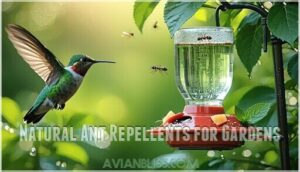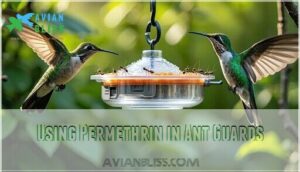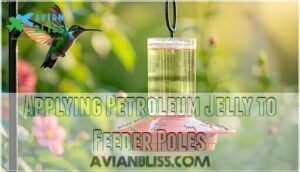This site is supported by our readers. We may earn a commission, at no cost to you, if you purchase through links.

Install ant moats filled with water above your feeder – these tiny creatures can’t swim across the gap. Apply petroleum jelly around feeder poles to create a slick surface ants can’t climb.
Position feeders away from trees and fences where ants travel like superhighways. Clean up nectar drips immediately since they leave scent trails for other ants to follow.
Natural repellents like cinnamon or mint plants near your feeder also work well. These simple tricks protect your birds’ food while keeping those persistent invaders at bay without harming anyone.
Table Of Contents
- Key Takeaways
- Preventing Ant Infestations
- Keeping Ants Away
- Natural Barriers and Deterrents
- Maintaining Feeder Health
- Effective Feeder Placement
- Frequently Asked Questions (FAQs)
- How do you keep ants out of a hummingbird feeder?
- How to keep ants away from hummingbird feeders?
- How to deter bees from hummingbird feeders?
- Do hummingbird feeders have ant moats?
- How to prevent ants from a hummingbird feeder?
- Why do you put aluminum foil on hummingbird feeders?
- How do I make my hummingbird feeder ant proof?
- Will vaseline keep ants away?
- How often should I replace my hummingbird feeder?
- What attracts ants to hummingbird feeders initially?
- Conclusion
Key Takeaways
- Install water barriers above your feeder – Use ant moats filled with water since ants can’t swim across the gap, and add a drop of dish soap to break surface tension for better effectiveness.
- Create slippery obstacles on feeder poles – Apply petroleum jelly around the middle section of poles to prevent ants from climbing up, and reapply every 2-3 weeks or after heavy rain.
- Position feeders strategically away from ant highways – Hang feeders away from trees, fences, and other surfaces that ants use to travel, and consider using fishing line or suspension cables for additional protection.
- Maintain clean feeders and eliminate attractants – Clean up nectar drips immediately, wash feeders daily with mild soap, and check for leaks regularly since sticky residue creates scent trails that attract more ants.
Preventing Ant Infestations
You’ll find that ants treat your hummingbird feeder like an all-you-can-eat buffet, marching in organized lines to steal the sweet nectar meant for your feathered friends.
Ants see your hummingbird feeder as their personal sugar paradise—but you can shut down their sweet operation.
The good news is that you can stop these tiny invaders with simple water barriers and smart placement techniques that create an impassable fortress around your feeder, utilizing simple methods to secure your feeder.
Using Ant Moats as Barriers
Why struggle with ants when water creates an unbeatable barrier? Ant moats are water-filled cups that hang above your hummingbird feeder, ants simply can’t cross.
These antproof feeder solutions work because ants can’t swim. You can find a suitable ant moat feeder online.
- DIY Moat Construction using bottle caps costs under $2
- Soap Addition breaks water tension for better ant control methods
- Water Evaporation requires checking levels every 2-3 days
- Moat Placement should hang directly above the feeder
- Refilling Frequency increases during hot weather for effective ant prevention tips, and it’s essential for maintaining an unbeatable barrier with ant moats and ensuring antproof feeder solutions.
Creating Physical Barriers With Water
You can create effective water barriers without buying commercial products.
DIY Ant Moats using bottle caps work perfectly—just add water with a drop of dish soap.
The Soap Surface Tension trick guarantees ants sink instead of floating across.
Water Depth Matters too; maintain at least half an inch.
These simple Water Barrier solutions stop ants cold.
Hanging Feeders Over Water Sources
You can create the ultimate water barrier by positioning your feeder above birdbaths, fountains, or other water features.
This natural moat strategy works because ants can’t swim across large water expanses.
Here are three effective water source placements:
- Birdbath positioning – Hang feeders directly over shallow birdbaths for dual-purpose ant prevention
- Fountain feeder combos – Install feeders above decorative fountains for maximum water barrier height
- Pond placement – Position near garden ponds while maintaining mosquito control and algae prevention
Keeping Ants Away
When ants discover your sweet hummingbird nectar, they’ll invite their entire colony to the feast.
You can stop this invasion using ant guards with safe chemicals or natural repellents that won’t harm your feathered friends.
Ant Guards and Chemical Repellents
When ant moats fail, ant guards containing Permethrin provide your next line of defense.
These chemical barriers attach above feeders, creating a safe zone that repels crawling invaders.
Permethrin Safety is excellent—it’s used in human medications and won’t harm birds or pets.
A popular alternative involves using DIY ant moats made from household items.
Commercial ant guards cost $5-$10 and offer foolproof protection when physical barriers aren’t enough.
Natural Ant Repellents for Gardens
Beyond chemical options, you can harness nature’s own pest-fighting arsenal.
Neem oil spray and diatomaceous earth create effective barriers around feeder bases. Sprinkle cayenne pepper or cinnamon for natural ant repellents that disrupt their trails.
Mix lemon water or vinegar solution as natural remedies. For example, you can use peppermint essential oil to deter ants.
These natural solutions keep ants away while protecting hummingbirds and beneficial garden insects from harsh chemicals.
Using Permethrin in Ant Guards
When natural methods fall short, permethrin-based ant guards pack serious punch.
You’ll install these chemical barriers directly above your feeder, creating an invisible shield ants can’t cross.
Permethrin safety around birds is well-established—it’s the same compound used in human lice treatments.
Guard lifespan typically runs six months before replacement.
Proper installation guarantees maximum ant prevention without bird impact concerns, using permethrin and ensuring maximum ant prevention.
Natural Barriers and Deterrents
You can create effective ant barriers using simple household items and natural deterrents that won’t harm your feathered friends.
These methods work by making surfaces too slippery for ants to climb or creating scents that send them marching in the opposite direction, using simple household items.
Applying Petroleum Jelly to Feeder Poles
Slippery petroleum jelly creates an effective ant barrier when applied to feeder poles. This simple trick stops ants from climbing up to your nectar source.
- Apply a thin layer around the pole’s middle section
- Reapply every 2-3 weeks or after heavy rain
- Choose food-grade petroleum jelly for safety
- Clean the pole before each application
The slippery surface prevents ants from gaining traction while remaining harmless to birds. You can purchase food-safe jelly products online.
Using Cinnamon and Essential Oils
Mother Nature provides powerful weapons against ant invasions through aromatic spices and plant oils.
Sprinkle cinnamon around feeder hooks to create an effective barrier—its volatile compounds confuse ant scent trails.
Mix tea tree oil with water for DIY recipes that pack serious punch.
These natural repellents offer oil safety while targeting ant scent preferences without harming hummingbirds.
To maintain a healthy environment, it’s important to clean feeders regularly to prevent disease, ensuring the well-being of hummingbirds.
Growing Mint Plants Around Feeder Poles
Planting mint around your feeder poles creates a living ant barrier that keeps working.
Choose spearmint or peppermint for best results. Space plants 18 inches from poles for ideal ant deterrents without crowding.
Mint propagation happens quickly, so trim regularly to prevent spreading.
The strong scent disrupts ant trails naturally, making this one of the most effective hummingbird feeder ants solutions available, using mint to keep ants away.
Maintaining Feeder Health
You’ll win the ant battle by keeping your feeder clean and leak-free, just like maintaining your car prevents bigger problems down the road.
Daily cleaning removes sticky sugar residue that acts like a welcome mat for ants, while checking for leaks stops the sweet drips that create ant highways to your feeder.
Regular Cleaning and Maintenance
Daily cleaning hummingbird feeder prevents residue buildup that attracts ants like magnets.
Use mild soap for thorough feeder sanitization, wiping every surface clean. Think of it as brushing your teeth – routine implementation makes all the difference.
Clean feeders during your regular watering schedule for easy feeder maintenance. Consistent bird feeder maintenance and proper feeder hygiene ants simply can’t resist becomes their worst nightmare, ensuring proper feeder hygiene is key to preventing issues, and making routine implementation a crucial part of the process.
Preventing Leaks in Hummingbird Feeders
Feeder leaks create sticky ant highways straight to your nectar supply. Weather effects like heat cause nectar expansion, while component wear from UV exposure weakens seals over time.
Think of feeder leaks as rolling out the red carpet for an ant invasion—every sticky drop becomes their personal highway to hummingbird heaven.
Proper leak detection and prevention keeps ants at bay. Some owners find that an ant moat is effective at keeping pests away.
Essential Leak Prevention Steps:
- Inspect feeder material weekly for cracks or warped plastic
- Check rubber gaskets monthly for deterioration and proper fit
- Monitor for drips after windy weather or temperature changes
Rotating Feeder Locations
Once you’ve fixed those pesky leaks, it’s time to play musical chairs with your hummingbird feeder.
Moving your feeder to new vantage points every few weeks helps disrupt ant trails and reduce ant presence around established colonies.
This simple rotation strategy can minimize feeder competition while offering variety to your feathered friends’ dining experience and keeping those persistent ants guessing, which is a key part of maintaining a hummingbird feeder and ensuring the health of the established colonies.
Effective Feeder Placement
Strategic feeder placement can make the difference between enjoying happy hummingbirds and watching an ant parade march to your sugar water buffet.
You’ll want to choose spots that naturally discourage ants while keeping your feeder accessible to those tiny flying jewels.
This approach will help you enjoy happy hummingbirds and avoid the issues associated with ant infestations at your feeder.
Choosing Shady Spots Away From Trees
Smart hummingbird feeder placement starts with finding that perfect shady spot.
You’ll want ideal sunlight filtering through leaves while avoiding bridges like tree branches that give ants easy access.
Shady locations with shade plants nearby minimize leaks from heat expansion.
Consider wind exposure too – calmer spots reduce spillage that attracts unwanted visitors to your feeder location.
Hanging Feeders With Suspension Cables
When you string your feeder on suspension cables, you’re creating a slippery highway that ants can’t navigate.
The thin cable material makes it nearly impossible for ants to maintain their grip, especially when combined with strategic cable attachment points.
To further enhance the feeder’s appeal, consider the feeder’s sun exposure.
- Cable Material: Choose thin fishing line or smooth metal cables that provide minimal grip for ants climbing feeder
- Cable Length: Maintain at least 18 inches between attachment points to prevent ant bridges
- Cable Stability: Secure cable attachment firmly to prevent wobbling that could create ant pathways
- Visual Appeal: Position cables to complement your garden’s aesthetic while maintaining functionality
- Petroleum Jelly Barrier: Apply a thin coating to cable ends as an additional feeder ant barrier, creating an ant moat effect
Relocating Feeders to Prevent Ant Colonization
Sometimes the best ant control strategy involves playing musical chairs with your hummingbird feeder.
Moving feeders every few weeks disrupts colony establishment and forces ants to start their navigation process from scratch.
This simple habitat selection change breaks their resource availability patterns and prevents long-term ant colonization around your favorite feeding spots.
| Relocation Strategy | Benefits |
|---|---|
| Weekly moves within 10-foot radius | Disrupts scent trails and confuses scout ants |
| Seasonal placement changes | Prevents permanent colony establishment |
| Height variation (4-6 feet) | Forces ants to rebuild access routes |
| Shade-to-sun shifts | Alters environmental conditions ants prefer |
| Distance from ant highways | Reduces discovery by foraging worker ants |
Frequently Asked Questions (FAQs)
How do you keep ants out of a hummingbird feeder?
Ants invade 70% of hummingbird feeders within days of setup.
Use water-filled ant moats above your feeder, apply petroleum jelly to poles, or hang feeders from fishing line to create slippery barriers ants can’t cross.
How to keep ants away from hummingbird feeders?
Use ant moats filled with water above your feeder – ants can’t swim across.
You’ll also want to hang feeders from fishing line and apply petroleum jelly to poles for extra protection.
How to deter bees from hummingbird feeders?
Your feeder becomes a buzzing bee highway when they discover the sweet nectar.
Choose feeders with bee guards, avoid yellow colors, and relocate feeders frequently to break their flight patterns and keep them guessing.
Do hummingbird feeders have ant moats?
Most quality hummingbird feeders come with built-in ant moats that you’ll need to fill with water.
If yours doesn’t have one, you can easily buy a separate ant moat for under ten dollars.
How to prevent ants from a hummingbird feeder?
Stop ants, save nectar, protect feeders—use water-filled ant moats above your feeder. You’ll create an impassable barrier since ants can’t swim. Add petroleum jelly to poles for extra protection.
Why do you put aluminum foil on hummingbird feeders?
Aluminum foil creates a slippery barrier that ants can’t grip when climbing feeder poles.
You wrap it around the pole below the feeder, forming a smooth surface that blocks their upward journey effectively.
How do I make my hummingbird feeder ant proof?
Install an ant moat above your feeder and fill it with water.
Ants can’t swim across this barrier.
You can also hang feeders from fishing line or apply petroleum jelly to poles.
Will vaseline keep ants away?
Petroleum jelly blocks 97% of ant invasions when applied to feeder poles.
You’ll create a slippery barrier ants can’t cross.
Simply coat the pole generously, but reapply after rain washes it away.
How often should I replace my hummingbird feeder?
Replace your hummingbird feeder every 2-3 years or when you notice cracks, leaks, or worn parts.
Older feeders break down faster and attract more ants through sugar leaks and residue buildup.
What attracts ants to hummingbird feeders initially?
Like tiny treasure hunters following a golden trail, ants discover your feeder through sweet nectar leaks, sticky residue on surfaces, and spilled sugar water around the base.
They’re drawn to any sugary scent you’ve accidentally left behind.
Conclusion
Victory over these tiny invaders isn’t rocket science when you’ve got the right arsenal.
You’ll master how to keep ants out of your hummingbird feeder by combining water barriers, strategic placement, and natural deterrents.
Remember that consistency beats perfection—clean spills quickly and maintain your ant moats regularly.
Your feathered friends will thank you for their protected nectar buffet, while those determined ants will find easier targets elsewhere in your garden, which is why natural deterrents are so important.
- https://www.pinterest.com/search/pins/?q=diy%20ant%20moat%20for%20hummingbird%20feeder&rs=rs&eq=&etslf=3581&term_meta[]=diy%20ant%20moat%20for%20hummingbird%20feeder%7Crecentsearch%7C0
- https://goto.walmart.com/c/1943169/565706/9383?subId1=homesandgardens-us-1411402774410399436&sharedId=homesandgardens-us&u=https%3A%2F%2Fwww.walmart.com%2Fip%2FMcCormick-Kosher-Ground-Cinnamon-2-37-oz-Bottle%2F10535029
- https://www.flockingaround.com/about-us
- https://www.tipsbulletin.com/how-to-keep-ants-out-of-a-hummingbird-feeder/
- https://feederbirds.com/how-to-keep-ants-out-of-hummingbird-feeders/











